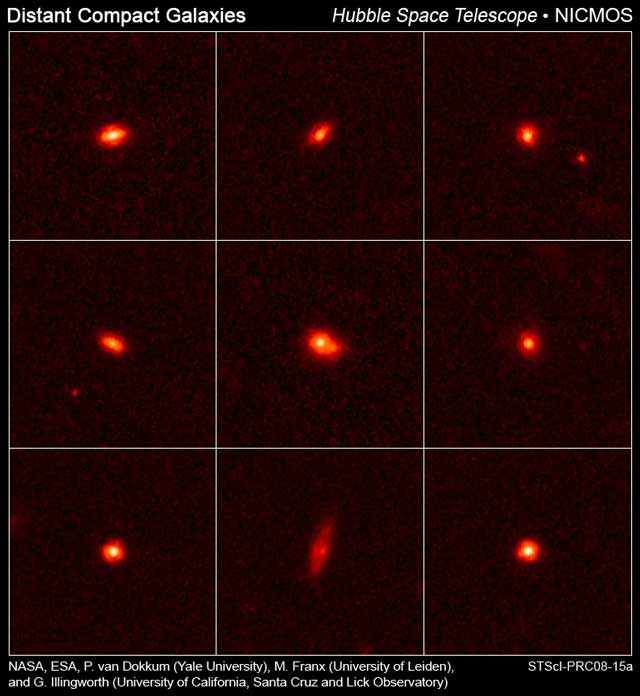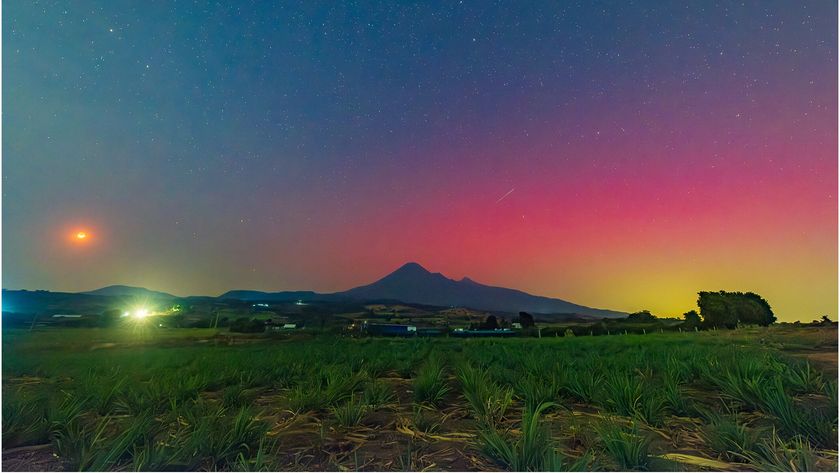Young Galaxies Surprisingly Packed with Stars

Several newfound galaxies seen as they existed when the universe was young are packed with improbable numbers of stars.
Astronomers don't know what's going on.
The nine galaxies are 11 billion light-years away, which means the light astronomers are looking at left the galaxies 11 billion years ago, when the universe was less than 3 billion years old.
Each of the newly studied galaxies weighs about 200 billion times the mass of the sun yet is a mere 5,000 light-years across. Our Milky Way Galaxy stretches across 100,000 light-years of space.
The compact galaxies have been furiously forming stars; each contains as many stars as a typical large galaxy of today, the new observations reveal.
"Seeing the compact sizes of these galaxies is a puzzle," said Pieter G. van Dokkum of Yale University, who led the study. "No massive galaxy at this distance has ever been observed to be so compact."
Since no modern galaxies, that is galaxies in the nearby universe, are so compact, the scientists assume compact galaxies from the early universe must have gotten much larger as they matured beyond the snapshots of ancient time now being studied. But nobody knows how.
Get the Space.com Newsletter
Breaking space news, the latest updates on rocket launches, skywatching events and more!
"They would have to change a lot over 11 billion years, growing five times bigger," van Dokkum said. "They could get larger by colliding with other galaxies, but such collisions may not be the complete answer."
Astronomers used NASA's Hubble Space Telescope and the W.M. Keck Observatory on Mauna Kea, Hawaii to make the new observations, which were announced today and were detailed in the April 10 issue of the Astrophysical Journal Letters.
Van Dokkum and his colleagues had previously studied the galaxies in 2006 with the Gemini South Telescope to determine their distances, and showed that the stars are a half a billion to a billion years old. The most massive stars had already exploded as supernovae.
One reason these galaxies were so dense, van Dokkum suggested, involves the interaction of dark matter and hydrogen gas in the nascent universe. Dark matter is an invisible form of matter that accounts for most of the universe's mass. Shortly after the theoretical Big Bang, the universe contained an uneven landscape of dark matter. Hydrogen gas became trapped in puddles of the invisible material, the thinking goes, and began spinning rapidly in dark matter's gravitational whirlpool, forming stars at a furious rate.
Based on the galaxies' mass, the astronomers estimated that the stars are spinning around their galactic disks at roughly 890,000 to 1 million mph (400 to 500 kilometers a second). Stars in today's galaxies, by contrast, are traveling at about half that speed because the setups are larger and rotate more slowly.
- Video: Our Corner of the Cosmos
- The Strangest Things in Space
- Video: Getting Started in Astronomy
Join our Space Forums to keep talking space on the latest missions, night sky and more! And if you have a news tip, correction or comment, let us know at: community@space.com.

Space.com is the premier source of space exploration, innovation and astronomy news, chronicling (and celebrating) humanity's ongoing expansion across the final frontier. Originally founded in 1999, Space.com is, and always has been, the passion of writers and editors who are space fans and also trained journalists. Our current news team consists of Editor-in-Chief Tariq Malik; Editor Hanneke Weitering, Senior Space Writer Mike Wall; Senior Writer Meghan Bartels; Senior Writer Chelsea Gohd, Senior Writer Tereza Pultarova and Staff Writer Alexander Cox, focusing on e-commerce. Senior Producer Steve Spaleta oversees our space videos, with Diana Whitcroft as our Social Media Editor.









